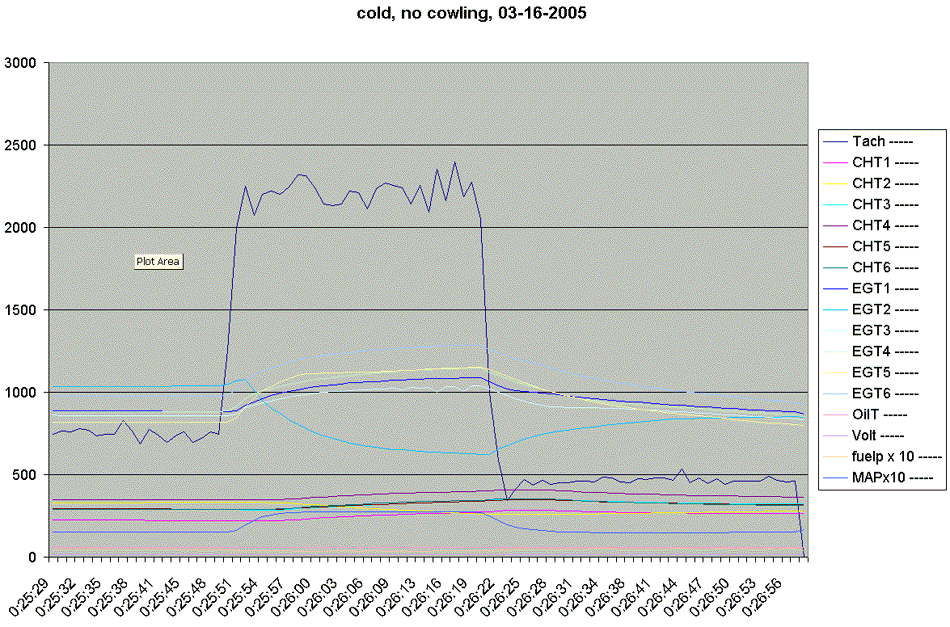EIS data logging
EIS (Engine Information System) Data Logging
created March 16, 2005
I've been having some "anomalies" with my engine, so I finally got smart and decided it'd be nice to actually KNOW what was going on, rather than trying to decipher my EIS 6000 screen real time. The EIS has a neat "serial output" feature that's an extra ten bucks. It's just a 9 pin connector for your laptop, and a little executable that logs all EIS outputs to a text file. It uses one of the wires from the EIS's 29 pin connector, along with a power and a ground wire. See run3.txt for an example text file. Once the text file is saved, it's fairly simple to create a chart in Excel (and I don't know diddly about Excel).

This run was created after running the engine with no cowling for 25 minutes, while warming up the oil (I was checking for carb icing and carb heat performance). Ambient temp was about 45 degrees, and it was misting. This run is just a 1.5 minute snapshot, mainly because my laptop rebooted itself at the 20 minute point. What is painfully obvious in this image is that cylinder number 2 takes a nose dive just as the throttle is advanced to wide open. The squiggly blue line is rpm (the EIS tach function is neither accurate nor steady on my engine), so as soon as rpm climbs, the fire in number two goes out, and the CHT (yellow) starts dropping as well. Up until then, number 2 and number 6 are hotter than the rest, but I'm pretty sure that's because I removed (to swap) and cleaned both thermocouple probes with Scotchbrite yesterday. I need to take all six probes and put them in something the same temp (like 1200F) and compare them all. My bet is that they are off, but cleaning them all may bring them back to closer in line with each other. Having said that, there is no doubt that #6 is practically white, while #2 is black, so there is definitely a difference between those two ends of the intake log.
Anyway, if you stare at this run for about 20 minutes, you'll notice all kinds of neat stuff. Amazing what 1.5 minutes of data can do for your understanding of an engine! My guess is that the spark plug is simply failing at high rpm, so I'll replace it tomorrow and try it again. Another clue is that it immediately comes back as the throttle is reduced, which to me means plug failure when cylinder pressure climbs. When I used to work at the Ramstein Auto Hobby Shop, we had a plug tester that applied spark and pressure, and you could make the bad ones fail by cranking the pressure up. I think that's what's happening to this one. I knew it was rough and wanted the data log to analyze the problem, but am quite happy to know that my engine would turn 2700 rpm on only five cylinders! And it's not rough enough to make you wonder if the engine is going to depart the airframe, just rough enough to let you know that something's not quite right. I've been complaining for months that my engine was not as smooth as other Corvairs I'd seen, and it wouldn't turn my prop as high as I thought it should. Now I know why!
See more on the EIS at the Grand Rapids Technologies website. Greg has assured us Corvair folks that he will find the answer to this tach problem, and we'll let you know what it is when he does...
Contact Mark Langford (if you must) at N56ML "at" hiwaay.net
Return to Corvair Engine
